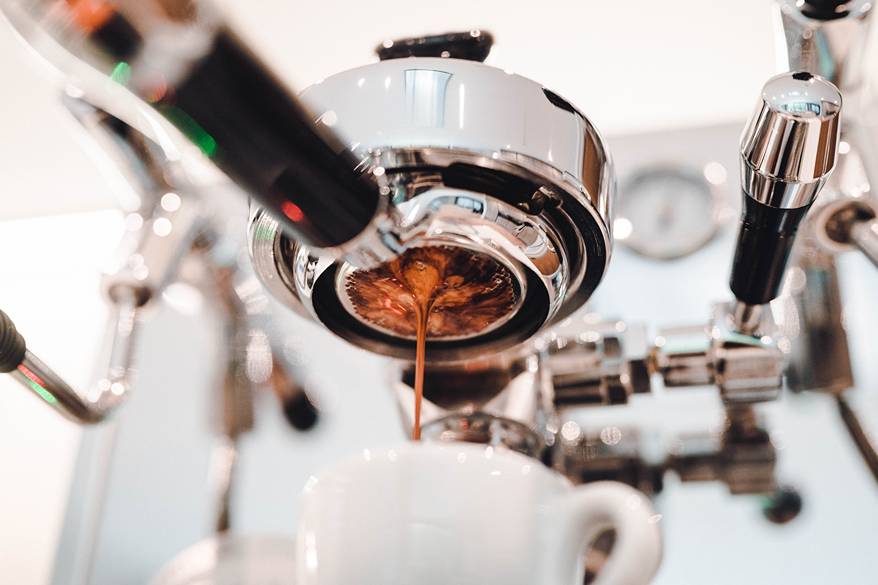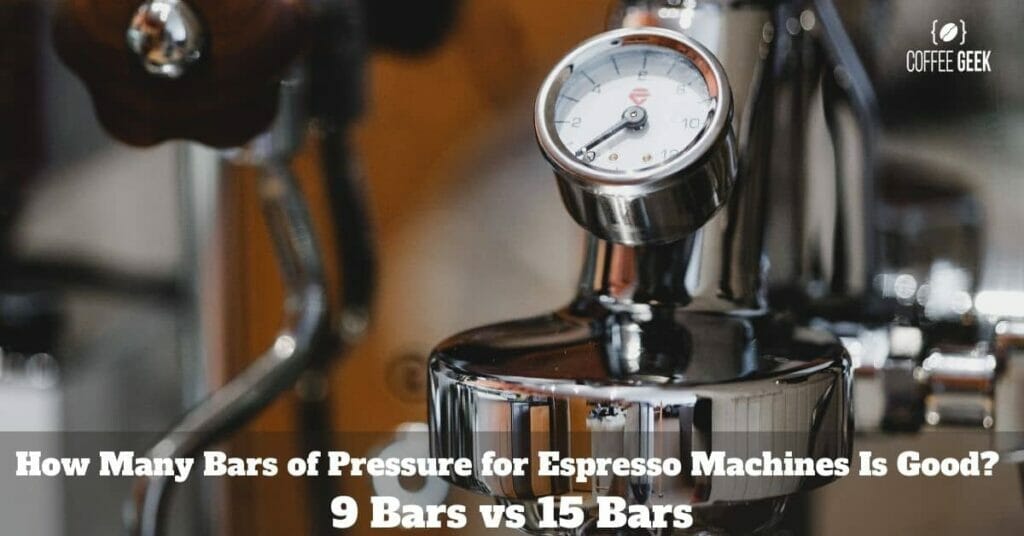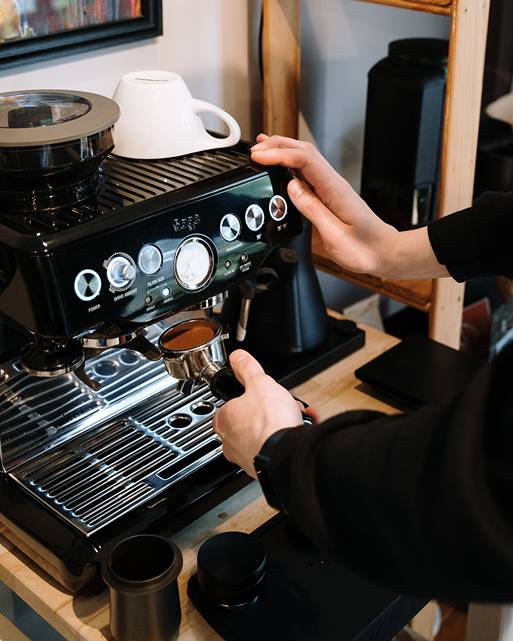If you’re new to espresso, you might be wondering how many bars of pressure for espresso machines is good. I’m here to help clear that up for you.
Espresso is a type of coffee that is made by forcing hot water through very finely ground coffee beans.
It is traditionally made using a pump espresso machine, which uses high pressure to force the hot water through the coffee grounds.
The pump espresso machines can vary in the amount of pressure they use, but most commonly they are either 9 bars or 15 bars.
So, how much pressure is good for espresso?
I’ll explain what the bars of pressure mean and how they affect the taste of espresso. I’ll also give you my opinion on whether 9-bar or 15-bar espresso machines are better.

And finally, I’ll answer some common questions about pump-driven espresso machines and pressure.
Let’s start by looking at what the bars of pressure mean.
What Do Bars of Pressure for Espresso Machines Mean?
Before I answer the question of how many bars of pressure for a good espresso, it’s important to understand what bars of pressure actually means.
The term “bar” is a unit of measure just like “mph” or “kilograms.” It’s a way of quantifying pressure.
One bar is equal to the atmospheric pressure at sea level, which is about 14.7 psi or pounds per square inch.
So, 9 bars of pressure means that the machine is creating 9 times the atmospheric pressure at sea level.
This might not seem like much, but it’s actually a lot of pressure.
The pressure in a car tire is typically between 30 and 35 psi. So, 9 bars of pressure is like having 3 car tires pushing against the coffee grounds.
As you can imagine, this high pressure is necessary to force the hot water through the coffee grounds and create a great-tasting espresso.
Previously, espresso machines used steam pressure to force the hot water through the coffee grounds.
However, with the advances in technology, steam-driven machines have largely been replaced by pump-driven machines, which are much more consistent and efficient.
The pump-driven machines can create either 9 bars or 15 bars of pressure. Some high-end espresso machines can even create up to 18 bars of pressure.
So, how does this pressure affect the coffee? I’ll explain that next.
How Does the Pressure Affect Espresso Quality
I know you’re probably wondering how the pressure affects espresso quality. After all, isn’t espresso just coffee?
As it turns out, the pressure has a big impact on espresso quality.
When you extract espresso, you’re not just trying to extract the coffee flavor.
You’re also trying to extract the oils and soluble solids from the espresso beans.
These oils and soluble solids are what give espresso its characteristic flavor, body, and crema.
If the espresso is extracted at too high of a pressure, the contact time between the water and coffee grounds will be too short. This will result in espresso that is weak and watery.
On the other hand, if the espresso is extracted at too low of a pressure, the contact time between the water and coffee grounds will be too long.
This will result in espresso that is too strong and bitter.
So, you have to find the perfect balance between the pump bar pressure, water temperature, coffee grind, and consistency to produce espresso that is flavorful and well-balanced.
How Many Bars of Pressure for Espresso Machines Pump Is Good?
In my opinion, espresso extracted at 9 bars is more flavorful and has a better body than espresso extracted at 15 bars.
The reason is that the 9-bar espresso has a longer contact time with the coffee grounds, which allows for more complete extraction of the oils and soluble solids.
The 15-bar espresso, on the other hand, has a shorter contact time with the coffee grounds.
This results in a less flavorful and less full-bodied espresso.
Of course, the extraction time is just one variable that affects the quality of the espresso.
The other variables, such as water temperature, coffee grind, and consistency, are also important.
So, if you’re looking for a well-balanced espresso, I would recommend using budget espresso machines that create 9 bars of pressure.
9 Bar vs 15 Bar Espresso Machines
I know some of you might be wondering if it’s worth it to buy an espresso coffee maker that creates 15 bars of pressure.
In my opinion, it’s not worth it. Here’s why:
A higher-pressure espresso coffee machine has the potential to produce more power under the hood, but it’s not always necessary.
This is because most of this power is not fully utilized.
To help you understand this, think about it this way:
You wouldn’t buy a car that can go 200 mph when the speed limit is only 55 mph.
So, why would you buy an espresso coffee machine that can create 15 bars of pressure when the optimum brew pressure is only 9 bars? It’s a waste of money.
You’re better off buying an espresso coffee maker that can create 9 bars of pressure.
This is because it will be more than enough to produce great-tasting espresso without the risk of bitterness.
Many espresso machines have a valve that ensures that the coffee is only extracted at 9 about bars of pressure. So, the extra pressure is constantly released and never used.
Final Verdict: Is 9 Bar or 15 Bar Better in a Pump Espresso Machine?
Any barista will tell you that the sweet spot for making espresso is 9 bars, and that is the pressure used in coffee makers.
However, many espresso machines come with a pump that can produce 15 or 18 bars of pressure.
The question is: Should you use the higher pressure? As I’ve explained, the answer is no.

While the coffee machine says it can produce 15 or 18 bars at the start of the extraction, it will automatically release some of that pressure during the brewing process.
So, by the time it gets to the pump (brew head), the pressure has already been reduced to around 9 bars.
This is the ideal brew head pressure for making espresso, and it’s the pressure used in a professional espresso machine.
If you’re looking for a well-balanced new espresso machine, I would recommend one of these espresso machines that are under $1,000 that creates 9 bars of pressure.
These machines are more than capable of producing better espresso without the risk of bitterness.
FAQs
How Do You Make Espresso Coffee?
The espresso coffee-making process begins by grinding coffee beans to a fine powder.
This powder is then placed in a filter and inserted into the espresso machine.
Once the filter is in place, hot water is forced through the coffee powder at high pressure.
This high pressure extracts the coffee and produces espresso.
The espresso is then collected in a small cup, and the coffee-making process is complete.
Is 15 Bar Enough for Espresso?
No, the ideal pressure for making espresso is 9 bars. Compared to 15 bars, 9 bars will result in a more flavorful espresso with a better body. However, 15 bars is still sufficient for making espresso since it gives the coffee makers an initial start of 10 – 11 bars of pressure which drops to around 9 during brewing.
Is 19 Bar Pressure Good for Espresso?
No, 19 bar pressure is not necessary for making espresso. In fact, it’s often too much pressure and can result in a bitter espresso. The optimum pressure for making espresso is 9 bars. This pressure results in a more flavorful espresso with a better body.
What Is 15 Bar Espresso?
15-bar espresso is an espresso maker that produces coffee at 15 bars of pressure. 15-bar espresso machines are not necessary for making espresso. In fact, they often produce coffee that is too bitter. The most suitable pressure for making espresso for restaurants and coffee shops is 9 bars.
Where Was the First Espresso Developed?
The first modern espresso machine was invented in Venice, Italy in the early 20th century by Luigi Bezzera. Luigi Bezzera was a businessman who was looking for a way to brew coffee faster.






